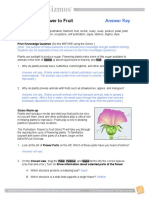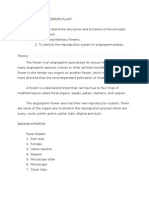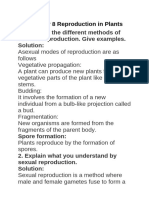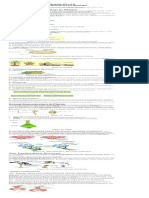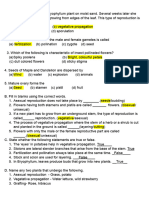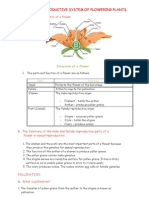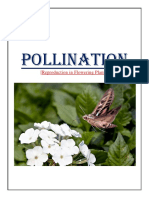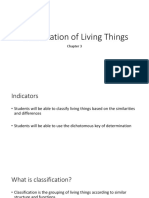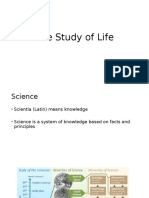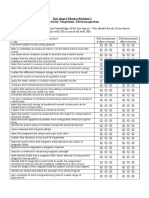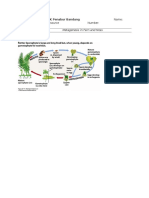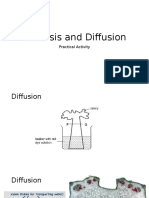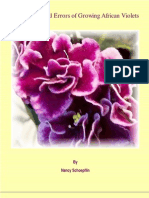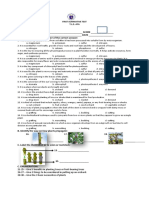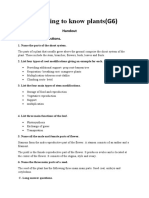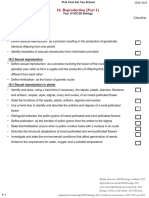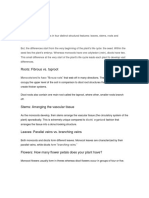Worksheet. 5. Sexual Reproduction in Plant
Worksheet. 5. Sexual Reproduction in Plant
Uploaded by
Leonita SwandjajaCopyright:
Available Formats
Worksheet. 5. Sexual Reproduction in Plant
Worksheet. 5. Sexual Reproduction in Plant
Uploaded by
Leonita SwandjajaOriginal Description:
Copyright
Available Formats
Share this document
Did you find this document useful?
Is this content inappropriate?
Copyright:
Available Formats
Worksheet. 5. Sexual Reproduction in Plant
Worksheet. 5. Sexual Reproduction in Plant
Uploaded by
Leonita SwandjajaCopyright:
Available Formats
SMPK1 BPK Penabur Bandung
Name:
Learning Resource
Number:
BIOLOGY
Group:
Sexual Reproduction in Flowering Plant
I.
Objective
To observe the structure of a flower and identify the function of every parts.
II.
Apparatus and materials
-
Hibiscus flower or any other flower
Forceps
Mounting needle
Microscope
Luv
Object glass
Cover glass
Razor or cutter
Petri dish
Sugar solution
III.
Theory
Reproduction in plants takes place in a variety of ways. This activity studies
the reproduction process in flowering plants that begins with a flower. The process
of sexual reproduction in flowering plants takes place in the flower which is a
complex structure made up of several parts. Most flowers have four major organs:
petals, sepals, stamens, and pistils. Some flowers are incomplete and do not
have all four organs. For example the squash plant has separate male and female
flowers, with the male flowers having stamens but no pistils and the female flowers
having pistils but no stamens. Some parts of the flower such as the stamens and
pistils are directly involved in fertilization and seed production. Other parts such as
the petals and sepals are not part of the sexual reproduction process but may be
essential to attracting a specific bird, bat, or insect to pollinate the flower.
For many plants, pollination is an important step towards sexual
reproduction. Pollination is the transport of pollen from the anther of a flower to the
stigma of (usually another) flower. Pollen is produced on the anther. Pollen is
brought from one flower to another by wind, insects, birds, or other such vectors.
Once pollen lands on the stigma of a flower, pollination is complete. However,
sexual reproduction has yet to take place. Thus, there is a difference between
pollination and fertilization, the union of egg and sperm.
To complete reproduction, the sperm cells in the pollen grain must be
transported down the style and brought to the egg cell within the ovary. This is the
job of the tube cell, another part of the pollen grain. The tube cell expands (it
doesnt divide) with the sperm cells held at its tip. It expands down the full length
of the style (sometimes quite a distance: the long tassels on ears of corn are
styles) until it reaches the opening of the ovary, and deposits the sperm cells at
the egg, or ovule. Fertilization has occurred when one sperm cell unites with one
egg cell.
IV.
V.
Procedure
a. Observe the flower as a whole, point and name the parts of the flower.
b. Cut the flower longitudinally and separate the stamen and pistil. Draw both stamen and
pistil then draw them in the observation part.
c. Make a fresh slide of pollen using glucose solution as the medium. Observe it under the
microscope and draw the pollen.
Observation
a. Label the whole flower diagram below.
b. Stamen, pistil and pollen.
-
VI.
Stamen
- -
Pistil
- -
Pollen
Questions
1. The male part of the flower is called ___________________, this structure is divided into
_________________ and _________________. The female part of the flower is called
_________________, this structure is divided into ___________________, __________________,
and ___________________.
2. The process in which the pollen touch the stigma is called __________________. The
process in which the pollen touch the stigma of another plant from the same species
but different in variety is called ____________________________________. The fusion
between male and female gametes in the flower is called ___________________.
3. Observe the image of the flowers below.
a. Which flower is a wind-pollinated flower?
______________________________________________________________________________
____
b. State three characteristics of wind-pollinated flowers.
- _______________________________________________________________________________
- _______________________________________________________________________________
- _______________________________________________________________________________
c. Give one example of wind-pollinated flower.
______________________________________________________________________________
____
d. Which flower is insect-pollinated?
______________________________________________________________________________
____
e. State two characteristics of insect-pollinated flower.
- _______________________________________________________________________________
- _______________________________________________________________________________
f. Name three insect-pollinated flowers.
______________________________________________________________________________
____
VII.
Conclusion
- ________________________________________________________________________________________
- ________________________________________________________________________________________
- ________________________________________________________________________________________
- ________________________________________________________________________________________
-
You might also like
- Pollination: Flower To Fruit: Answer KeyDocument5 pagesPollination: Flower To Fruit: Answer KeyPDX Frost40% (5)
- SCIENCE-5-Q2-Module 4Document16 pagesSCIENCE-5-Q2-Module 4Mary Ann Gabion100% (11)
- 02 - Diffusion and Osmosis - WorksheetDocument3 pages02 - Diffusion and Osmosis - WorksheetLuigi Battistini R.67% (3)
- RHS Fruit Tree PruningDocument3 pagesRHS Fruit Tree PruningCebotari TatianaNo ratings yet
- Flower Dissection Investigation PacketDocument7 pagesFlower Dissection Investigation PacketNicole McIntyreNo ratings yet
- Plant ReproductionDocument8 pagesPlant ReproductionExceil Matthew Carpio100% (1)
- Reproduction-among-Flowering-Plants (Navales and Munoz)Document10 pagesReproduction-among-Flowering-Plants (Navales and Munoz)richelyn navalesNo ratings yet
- Experiment of Angiosperm PlantDocument4 pagesExperiment of Angiosperm Plantganu8950% (2)
- Plants Reproduction and DevelopmentDocument6 pagesPlants Reproduction and DevelopmentAlwìn GarciaNo ratings yet
- Assignment 2022-PollinationFlowerFruitDocument6 pagesAssignment 2022-PollinationFlowerFruitjaveriaNo ratings yet
- Parts of A Flower Lesson Plan WbsDocument5 pagesParts of A Flower Lesson Plan WbsjonjammyNo ratings yet
- Lesson Notes - Integrated ScienceDocument3 pagesLesson Notes - Integrated ScienceSamantha Miller100% (3)
- Lecture 6B BIOL5 TranscriptDocument8 pagesLecture 6B BIOL5 TranscriptHannah Fae RotairoNo ratings yet
- Reproduction in PlantsDocument9 pagesReproduction in Plantsmr. unknownNo ratings yet
- LESSON 3 Perpetuation of LifeDocument7 pagesLESSON 3 Perpetuation of LifebrionesmaryshantelNo ratings yet
- g5q2 Week 6 ScienceDocument80 pagesg5q2 Week 6 Sciencearranejulius.gagarinNo ratings yet
- WKSH 3 Structure of Flowers - AnswersDocument2 pagesWKSH 3 Structure of Flowers - AnswersNandu SabkabanduNo ratings yet
- Chapter 12 Reproduction in PlantsDocument7 pagesChapter 12 Reproduction in Plantsth6zvp9cfsNo ratings yet
- Reproduction in Plants NotesDocument4 pagesReproduction in Plants NotesmessyinformallyNo ratings yet
- Angiosperm Life Cycle-Flowers, Fruits and SeedsDocument7 pagesAngiosperm Life Cycle-Flowers, Fruits and SeedsEunnie ChongNo ratings yet
- S5LT 11f 6Document8 pagesS5LT 11f 6Kristine Joy PitaNo ratings yet
- Reproductive System of Flowering, Non-Flowering, and Spore-BearingDocument34 pagesReproductive System of Flowering, Non-Flowering, and Spore-BearingJulie BalogoNo ratings yet
- Sexual reproduction in plants(notes)Document4 pagesSexual reproduction in plants(notes)atulya0kratosNo ratings yet
- Grade 7 Integrated Science Week 9 Lesson 2Document3 pagesGrade 7 Integrated Science Week 9 Lesson 2Keianna GillisNo ratings yet
- Sexual Reproduction in Plants CLASS 10Document5 pagesSexual Reproduction in Plants CLASS 10shallowNo ratings yet
- hoa đẹp quáDocument9 pageshoa đẹp quátranduchuy141No ratings yet
- Grade 5 PPT Science Q2 W6 Day 1-5Document75 pagesGrade 5 PPT Science Q2 W6 Day 1-5gerelyn matute100% (1)
- 4.8 Sexual Reproductive System of Flowering PlantsDocument16 pages4.8 Sexual Reproductive System of Flowering PlantsYu HasNo ratings yet
- INVESTIGATORY_PROJECT_SEXUAL_REPRODUCTION_IN_FLOWERING_PLANTSDocument10 pagesINVESTIGATORY_PROJECT_SEXUAL_REPRODUCTION_IN_FLOWERING_PLANTSVARUN SNo ratings yet
- 3.6 Sexual Reproduction in Flowering Plants SVDocument45 pages3.6 Sexual Reproduction in Flowering Plants SVEthan ChuNo ratings yet
- Ashely Jade Domalanta - Checked-SPLM-4-for-Gen-BiologyDocument5 pagesAshely Jade Domalanta - Checked-SPLM-4-for-Gen-BiologyAshley Jade DomalantaNo ratings yet
- lesson8 reproduction in plantsDocument10 pageslesson8 reproduction in plantsxojik45947No ratings yet
- Bio-2-4th-qtr-WORKSHEETS 2Document21 pagesBio-2-4th-qtr-WORKSHEETS 2divinegrace.ricarseNo ratings yet
- Plancess-Biology-Class-12 Removing Images and Watermark (3) Upto CH 10Document340 pagesPlancess-Biology-Class-12 Removing Images and Watermark (3) Upto CH 10lotus25369No ratings yet
- Gr12 - Reproduction in PlantsDocument14 pagesGr12 - Reproduction in PlantsZelNo ratings yet
- All About ReproductionDocument4 pagesAll About Reproductionawomemmanuel3No ratings yet
- Presentation 2Document21 pagesPresentation 2Maro Ridhwan RidhiwaniNo ratings yet
- Plant Parts - Flowers: PistilDocument8 pagesPlant Parts - Flowers: PistilDiana Marie MendozaNo ratings yet
- Q2 - W5 Science 5Document48 pagesQ2 - W5 Science 5Mac RamNo ratings yet
- Parts of A FlowerDocument2 pagesParts of A FlowerIrish cambriNo ratings yet
- Sexual Reproduction in PlantsDocument34 pagesSexual Reproduction in PlantsRhea JohnNo ratings yet
- Notes Ch-12 Reproduction in PlantsDocument1 pageNotes Ch-12 Reproduction in PlantsBobby NoharaNo ratings yet
- Plant Diversity Lecture 8-AngiospermsDocument22 pagesPlant Diversity Lecture 8-AngiospermsLebohang MakhanyaNo ratings yet
- Flowers and Fruits WorksheetDocument8 pagesFlowers and Fruits WorksheetfatimaNo ratings yet
- Parts of A FlowerDocument4 pagesParts of A FlowerJose Manuel S. AgradeNo ratings yet
- CLASS 7 CH 11 REPRODUCTION IN PLANTSDocument5 pagesCLASS 7 CH 11 REPRODUCTION IN PLANTSdivyanshubishnoi85No ratings yet
- Reproduction in PlantsDocument40 pagesReproduction in PlantsMegha SainiNo ratings yet
- Biology Project (Sexual Reproduction in Flowering Plants)Document6 pagesBiology Project (Sexual Reproduction in Flowering Plants)47. Anas SiddiquiNo ratings yet
- Flower and PollinationDocument3 pagesFlower and Pollinationeasylearning83No ratings yet
- The Sexual Reproductive System of Flowering PlantsDocument5 pagesThe Sexual Reproductive System of Flowering PlantsHafiy Yusoff100% (1)
- ANTHOPHYTEDocument3 pagesANTHOPHYTEIrish Nicole BigtasNo ratings yet
- PollinationDocument25 pagesPollinationArun0% (1)
- PERPETUATION OF LIFE NotesDocument11 pagesPERPETUATION OF LIFE NotesErnie Rosemarie T. BucalenNo ratings yet
- Principles of Plant Breeding MannualDocument49 pagesPrinciples of Plant Breeding Mannualsamritithakur44No ratings yet
- SexualAsexualReadingDocument2 pagesSexualAsexualReadingconner.partinNo ratings yet
- Bio Report6Document27 pagesBio Report6myvi3213No ratings yet
- Topic 10 Reproduction in Plants Revised Roysci Notes 2021Document14 pagesTopic 10 Reproduction in Plants Revised Roysci Notes 2021shealtielchigariso06No ratings yet
- PollinationFlowerFruitSE 1Document6 pagesPollinationFlowerFruitSE 1victor.mccoy1No ratings yet
- Chapter - 12 Reproduction in PlantsDocument5 pagesChapter - 12 Reproduction in Plantsanju singhNo ratings yet
- Reproduction in PlantsDocument8 pagesReproduction in PlantsJada MillerNo ratings yet
- Gardener's Guide to Seed Catalogs: Gardener's Guide Series, #3From EverandGardener's Guide to Seed Catalogs: Gardener's Guide Series, #3No ratings yet
- Classification of Living ThingsDocument32 pagesClassification of Living ThingsLeonita Swandjaja0% (1)
- Chapter 01. Introduction To BiologyDocument18 pagesChapter 01. Introduction To BiologyLeonita SwandjajaNo ratings yet
- Unit 2 ClassificationDocument18 pagesUnit 2 ClassificationLeonita Swandjaja100% (1)
- Bridging Class - Making A Graph: Dual Certificate Program (DCP)Document1 pageBridging Class - Making A Graph: Dual Certificate Program (DCP)Leonita SwandjajaNo ratings yet
- Worksheet - Microscope: Part A: How To Use A MicroscopeDocument2 pagesWorksheet - Microscope: Part A: How To Use A MicroscopeLeonita SwandjajaNo ratings yet
- Classification FinalDocument8 pagesClassification FinalLeonita SwandjajaNo ratings yet
- Bio FinalDocument7 pagesBio FinalLeonita SwandjajaNo ratings yet
- Chapter 01. Introduction To BiologyDocument18 pagesChapter 01. Introduction To BiologyLeonita SwandjajaNo ratings yet
- The Scientific MethodDocument2 pagesThe Scientific MethodLeonita SwandjajaNo ratings yet
- Key Stage 3 Physics Revision 1Document24 pagesKey Stage 3 Physics Revision 1Leonita SwandjajaNo ratings yet
- Name: Learning Resource Number:: SMPK1 BPK Penabur Bandung BiologyDocument1 pageName: Learning Resource Number:: SMPK1 BPK Penabur Bandung BiologyLeonita SwandjajaNo ratings yet
- Mitosis and Meiosis FactsDocument8 pagesMitosis and Meiosis FactsLeonita SwandjajaNo ratings yet
- Osmosis and Diffusion LabDocument7 pagesOsmosis and Diffusion LabLeonita SwandjajaNo ratings yet
- Classification of Living Things VocabularyDocument1 pageClassification of Living Things VocabularyLeonita SwandjajaNo ratings yet
- GenusDocument1 pageGenusLeonita SwandjajaNo ratings yet
- Cell DivisionDocument23 pagesCell DivisionLeonita Swandjaja100% (1)
- Reproductive Parts of Plants and Their FunctionsDocument5 pagesReproductive Parts of Plants and Their FunctionsPRINCESS BALISI100% (3)
- The Trials and Errors of Growing African VioletsDocument44 pagesThe Trials and Errors of Growing African VioletsMihai Miki100% (3)
- Plant Processes: 1. PhotosynthesisDocument2 pagesPlant Processes: 1. PhotosynthesisDaniel Dowding100% (1)
- Harbaugh Et Al. 1992. Rosetting of Lisianthus Cultivars Exposed To High TemepratureDocument3 pagesHarbaugh Et Al. 1992. Rosetting of Lisianthus Cultivars Exposed To High TemepraturePao GabrielNo ratings yet
- CRS001 Lab2Document14 pagesCRS001 Lab2Sanimah maruhomNo ratings yet
- PRPM110L Module 3 & 4Document10 pagesPRPM110L Module 3 & 4CASSANDRA REIGN CONSTANTINONo ratings yet
- The Story of OrchidDocument7 pagesThe Story of OrchidLilian Kimwell SastadoNo ratings yet
- Diseases of PotatoDocument8 pagesDiseases of PotatoAkash RoyNo ratings yet
- Unit 7. Autotrophic NutritionDocument48 pagesUnit 7. Autotrophic Nutritionmunyanezaolivier422No ratings yet
- Perpetuation of LifeDocument32 pagesPerpetuation of Lifeshellaorocio00No ratings yet
- Plant TestDocument13 pagesPlant TestsubkumquatNo ratings yet
- Monocots and Dicots: Chart Showing Differences Monocot DicotDocument3 pagesMonocots and Dicots: Chart Showing Differences Monocot DicotCarina JLNo ratings yet
- Myrsinaceae. Flora of China. Vol. 15. 1996.Document38 pagesMyrsinaceae. Flora of China. Vol. 15. 1996.Dr. John PipolyNo ratings yet
- Sample Final PDFDocument3 pagesSample Final PDFshallypallyNo ratings yet
- Reproductive Flowering Plants Magnoliophyta Angiosperms SpermDocument17 pagesReproductive Flowering Plants Magnoliophyta Angiosperms Spermfilan0fisteku-502158No ratings yet
- Leaves: Form & FunctionDocument19 pagesLeaves: Form & FunctionShiba TatsuyaNo ratings yet
- Plant Structures and Physiology NotesDocument97 pagesPlant Structures and Physiology Notesapi-292966101No ratings yet
- MICROSPOROGENOSISDocument20 pagesMICROSPOROGENOSISMerlyn CuantiosoNo ratings yet
- ST 1 - Tle 6 - Q1Document2 pagesST 1 - Tle 6 - Q1CalNo ratings yet
- Selina Solutions Concise Biology Class 10 Chapter 4 Absorption by Roots - The Processes Involved Available in Free PDFDocument1 pageSelina Solutions Concise Biology Class 10 Chapter 4 Absorption by Roots - The Processes Involved Available in Free PDFsam smithNo ratings yet
- Study MaterialDocument38 pagesStudy MaterialrutwickNo ratings yet
- Lecture 03 (AP)Document3 pagesLecture 03 (AP)Ravindi SamarasingheNo ratings yet
- Getting To Know Plants (G6) : Handout I. Short Answer QuestionsDocument4 pagesGetting To Know Plants (G6) : Handout I. Short Answer Questionsdon shiphrahNo ratings yet
- Amadumbe Amadumbe: Agriculture, Forestry & FisheriesDocument2 pagesAmadumbe Amadumbe: Agriculture, Forestry & FisheriesPhumakimi0% (1)
- IGCSE Reproduction in PlantsDocument10 pagesIGCSE Reproduction in Plantsvijayp22No ratings yet
- Chapter 36 Resource Acquisition and Transport in Vascular PlantsDocument12 pagesChapter 36 Resource Acquisition and Transport in Vascular Plants蔡旻珊No ratings yet
- Sexual Reproduction in Flowering Plant Mcq-3Document19 pagesSexual Reproduction in Flowering Plant Mcq-3indianequality86No ratings yet
- Leon 1919 Sid A Britton IDocument324 pagesLeon 1919 Sid A Britton IgeorgesidneybarachoNo ratings yet
- Monocot vs. Dicot: Roots: Fibrous vs. TaprootDocument3 pagesMonocot vs. Dicot: Roots: Fibrous vs. TaprootExequiel ZoletaNo ratings yet
